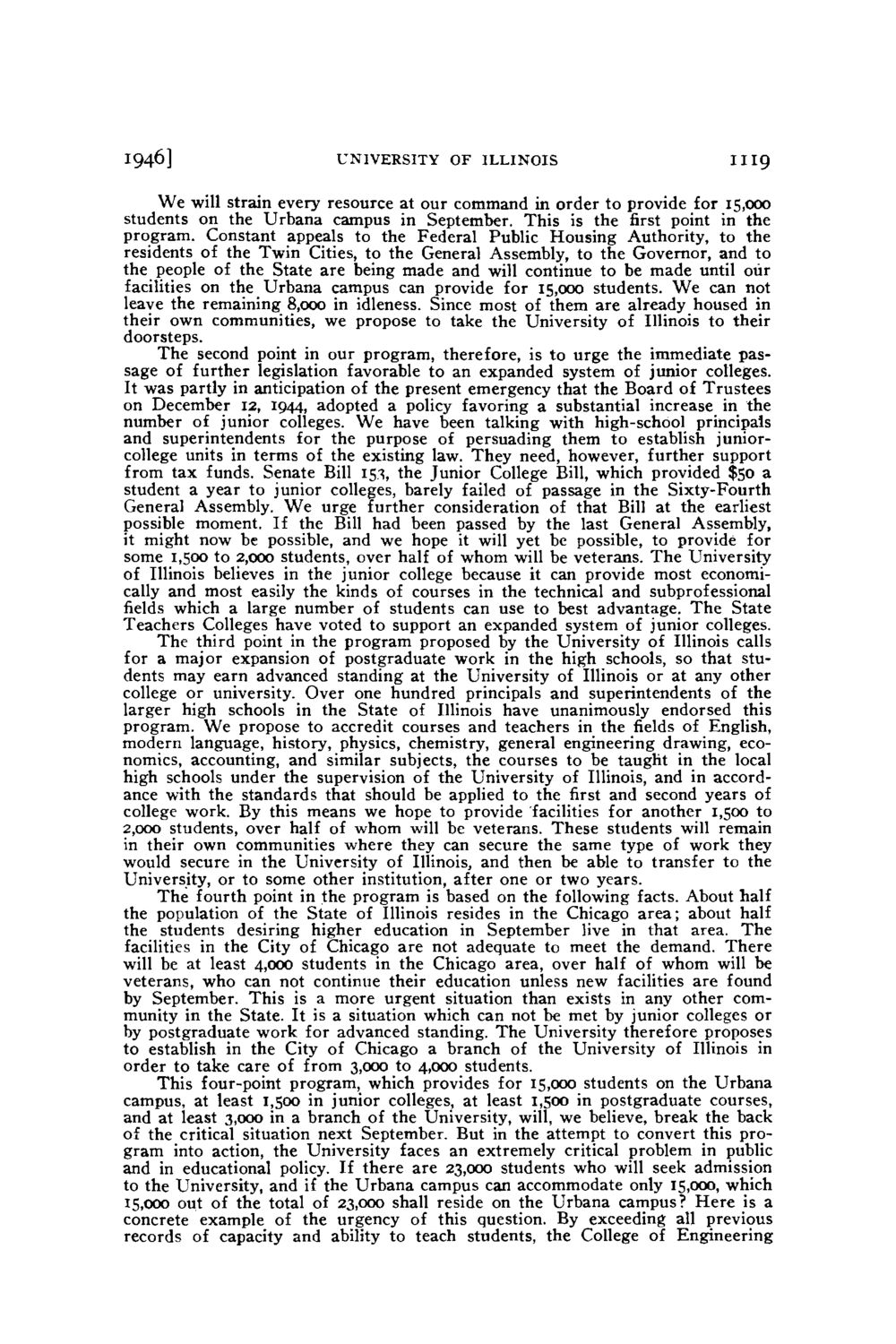| |
| |
Caption: Board of Trustees Minutes - 1946
This is a reduced-resolution page image for fast online browsing.

EXTRACTED TEXT FROM PAGE:
1946] UNIVERSITY OF ILLINOIS III9 We will strain every resource at our command in order to provide for 15,000 students on the Urbana campus in September. This is the first point in the program. Constant appeals to the Federal Public Housing Authority, to the residents of the Twin Cities, to the General Assembly, to the Governor, and to the people of the State are being made and will continue to be made until our facilities on the Urbana campus can provide for 15,000 students. W e can not leave the remaining 8,000 in idleness. Since most of them are already housed in their own communities, we propose to take the University of Illinois to their doorsteps. T h e second point in our program, therefore, is to urge the immediate passage of further legislation favorable to an expanded system of junior colleges. It was partly in anticipation of the present emergency that the Board of Trustees on December 12, 1944, adopted a policy favoring a substantial increase in the number of junior colleges. We have been talking with high-school principals and superintendents for the purpose of persuading them to establish juniorcollege units in terms of the existing law. They need, however, further support from tax funds. Senate Bill 153, the Junior College Bill, which provided $50 a student a year to junior colleges, barely failed of passage in the Sixty-Fourth General Assembly. W e urge further consideration of that Bill at the earliest possible moment. If the Bill had been passed by the last General Assembly, it might now be possible, and we hope it will yet be possible, to provide for some 1,500 to 2,000 students, over half of whom will be veterans. T h e University of Illinois believes in the junior college because it can provide most economically and most easily the kinds of courses in the technical and subprofessional fields which a large number of students can use to best advantage. T h e State Teachers Colleges have voted to support an expanded system of junior colleges. T h e third point in the program proposed by the University of Illinois calls for a major expansion of postgraduate work in the high schools, so that students may earn advanced standing at the University of Illinois or at any other college or university. Over one hundred principals and superintendents of the larger high schools in the State of Illinois have unanimously endorsed this program. We propose to accredit courses and teachers in the fields of English, modern language, history, physics, chemistry, general engineering drawing, economics, accounting, and similar subjects, the courses to be taught in the local high schools under the supervision of the University of Illinois, and in accordance with the standards that should be applied to the first and second years of college work. By this means we hope to provide facilities for another 1,500 to 2,000 students, over half of whom will be veterans. These students will remain in their own communities where they can secure the same type of work they would secure in the University of Illinois, and then be able to transfer to the University, or to some other institution, after one or two years. T h e fourth point in the program is based on the following facts. About half the population of the State of Illinois resides in the Chicago a r e a ; about half the students desiring higher education in September live in that area. T h e facilities in the City of Chicago are not adequate to meet the demand. There will be at least 4,000 students in the Chicago area, over half of whom will be veterans, who can not continue their education unless new facilities are found by September. This is a more urgent situation than exists in any other community in the State. It is a situation which can not be met by junior colleges or by postgraduate work for advanced standing. The University therefore proposes to establish in the City of Chicago a branch of the University of Illinois in order to take care of from 3,000 to 4,000 students. This four-point program, which provides for 15,000 students on the Urbana campus, at least 1,500 in junior colleges, at least 1,500 in postgraduate courses, and at least 3,000 in a branch of the University, will, we believe, break the back of the critical situation next September. But in the attempt to convert this program into action, the University faces an extremely critical problem in public and in educational policy. If there are 23,000 students who will seek admission to the University, and if the Urbana campus can accommodate only 15,000, which 15,000 out of the total of 23,000 shall reside on the Urbana campus? H e r e is a concrete example of the urgency of this question. By exceeding all previous records of capacity and ability to teach students, the College of Engineering
| |